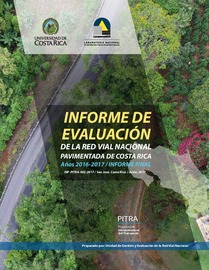| dc.contributor.author | Naranjo Ureña, Ronald | |
| dc.contributor.author | Sanabria Sandino, Jairo | |
| dc.contributor.author | Barrantes Jiménez, Roy | |
| dc.contributor.author | Loría Salazar, Luis Guillermo | |
| dc.date.accessioned | 2018-06-06T21:31:11Z | |
| dc.date.available | 2018-06-06T21:31:11Z | |
| dc.date.issued | 2017-06 | |
| dc.identifier.uri | https://www.lanamme.ucr.ac.cr/repositorio/handle/50625112500/1271 | |
| dc.description.abstract | Bajo el marco de la Ley No. 8114, le corresponde al LanammeUCR realizar una evaluación cada dos años del estado de la red vial nacional pavimentada, la cual sirve como instrumento eficaz e imparcial de rendición de cuentas y de planificación técnica para la gestión vial y de la inversión pública realizada.
Los parámetros técnicos con los que se realizó la evaluación de la red de carreteras en los años 2016 - 2017 están relacionados directamente con la vida útil o de servicio, con el costo de operación de la flota vehicular que circula y con la seguridad vial, al evaluar la fricción de la superficie en presencia de agua, generando condiciones críticas de frenado. Se utilizó el deflectómetro de impacto (FWD), para medir las deflexiones superficiales obtenidas al someter al pavimento a una fuerza que simula cargas de tránsito, lo que permite inferir la capacidad soportante de dicho pavimento, y con ello, la vida útil remanente en dicha estructura. Por otra parte, se utilizó el perfilómetro láser, el cual mide las irregularidades superficiales (IRI) de las vías, que se asocia tanto con el confort que siente el usuario que circula por dicho tramo, como principalmente con los costos de operación de los vehículos que usan las carreteras. En el tema de seguridad vial, el equipo de fricción o agarre (GRIP) permitió medir el coeficiente de rozamiento existente entre el pavimento y las llantas, lo que determina su adherencia a la calzada y que se relaciona directamente con el índice de peligrosidad de una ruta. Se genera un registro mediante fotografías georreferenciadas de la condición superficial de los pavimentos en el momento de su evaluación para poder analizar el tipo de deterioros presentes en la Red Vial Nacional. Adicionalmente, se realizó la evaluación de la inversión realizada entre enero del año 2014 y diciembre del año 2015 y su efecto en la condición final de la Red Vial Nacional, como un indicador de la eficiencia de la inversión, y una herramienta para la adecuada rendición de cuentas, promoviendo la transparencia y la gestión de la inversión en la Red Vial Nacional. | es |
| dc.description.abstract | Under the framework of Law No. 8114, it is the responsibility of the LanammeUCR to carry out an evaluation every two years of the condition of the paved national road network, which serves as an effective and impartial instrument of accountability and technical planning for road management and of the public investment made.
The technical parameters with which the evaluation of the road network was carried out in the years 2016 - 2017 are directly related to the useful life or service, with the operating cost of the vehicular fleet that circulates and with road safety, evaluate the friction of the surface in the presence of water, generating critical braking conditions. The impact deflectometer (FWD) was used to measure the surface deflections obtained by subjecting the pavement to a force that simulates traffic loads, which allows inferring the bearing capacity of said pavement, and with it, the remaining useful life in said pavement. structure. On the other hand, the laser profilometer was used, which measures the surface irregularities (IRI) of the tracks, which is associated both with the comfort felt by the user traveling through that section, and mainly with the operating costs of the vehicles. who use the roads. In terms of road safety, the friction or grip (GRIP) equipment allowed to measure the coefficient of friction between the pavement and the rims, which determines its adherence to the roadway and which is directly related to the hazard index of a route. A record is generated through georeferenced photographs of the surface condition of the pavements at the time of their evaluation in order to analyze the type of deterioration present in the National Road Network. Additionally, it was performed an evaluation of the investment made between January 2014 and December 2015 and its effect on the final condition of the National Road Network, as an indicator of the efficiency of the investment, and a tool for adequate accountability, promoting transparency and management of investment in the National Road Network. | es |
| dc.language.iso | es | es |
| dc.publisher | Laboratorio Nacional de Materiales y Modelos Estructurales (LanammeUCR) | es |
| dc.relation.ispartofseries | INF-PITRA-002-2017 | |
| dc.subject | PITRA | es |
| dc.subject | EVALUACIÓN | es |
| dc.subject | RED | es |
| dc.subject | VIAL | es |
| dc.subject | NACIONAL | es |
| dc.subject | PAVIMENTOS | es |
| dc.subject | ESTRATEGIAS | es |
| dc.subject | GESTIÓN | es |
| dc.subject | EVALUATION | es |
| dc.subject | NETWORK | es |
| dc.subject | ROAD | es |
| dc.subject | NATIONAL | es |
| dc.subject | PAVEMENTS | es |
| dc.subject | STRATEGIES | es |
| dc.subject | MANAGEMENT | es |
| dc.title | Informe de evaluación de la red vial nacional pavimentadad de Costa Rica años 2016-2017 | es |
| dc.type | informe técnico | es |
| dc.description.procedence | UCR::Vicerrectoría de Investigación::Unidades de Investigación::Ingeniería::LanammeUCR | es |

